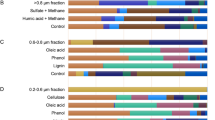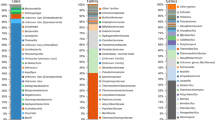Abstract
An isolation strategy, exploring novel microorganisms in frozen enrichment cultures (ENFE), which uses a combination of enrichment culture and 16S rRNA gene clone analysis, was evaluated for isolating uncultured thermophiles from a terrestrial acidic hot spring. The procedure comprised (a) multiple enrichment cultures under various conditions, (b) cryostorage of all enrichments, (c) microbial community analyses of the enrichments using 16S rRNA gene sequences, and (d) purification of microorganisms from enrichments containing previously uncultured microorganisms. The enrichments were performed under a total of 36 conditions, and 16 of these enrichments yielded positive microbial growth with the detection of three previously uncultured archaea. Two of the three previously uncultured archaea, strains HS-1 and HS-3, were successfully isolated. Strain HS-1 and HS-3 represented a novel lineage of the order Sulfolobales and novel species of the genus Sulfolobus, respectively. Although innovative isolation methods play strategic roles in isolating previously uncultured microorganisms, the ENFE strategy showed potential for characterizing and isolating such microorganisms using conventional media and techniques.


Similar content being viewed by others
References
Akanuma S, Nakajima Y, Yokobori S, Kimura M, Nemoto M, Mase T, Miyazono K, Tanokura M, Yamagishi A (2013) Experimental evidence for the thermophilicity of ancestral life. P Natl Acad Sci USA 110:11067–11072
Aoi Y, Kinoshita T, Hata T, Ohta H, Obokata H, Tsuneda S (2009) Hollow-fiber membrane chamber as a device for in situ environmental cultivation. Appl Environ Microbiol 75:3826–3833
Bae JW, Rhee SK, Park JR, Kim BC, Park YH (2005) Isolation of uncultivated anaerobic thermophiles from compost by supplementing cell extract of Geobacillus toebii in enrichment culture medium. Extremophiles 9:477–485
Becerra A, Delaye L, Lazcano A, Orgel LE (2007) Protein disulfide oxidoreductases and the evolution of thermophily: was the last common ancestor a heat-loving microbe? J Mol Evol 65:296–303
Ben-Dov E, Kramarsky-Winter E, Kushmaro A (2009) An in situ method for cultivating microorganisms using a double encapsulation technique. FEMS Microbiol Ecol 68:363–371
Bruns A, Cypionka H, Overmann J (2002) Cyclic AMP and acyl homoserine lactones increase the cultivation efficiency of heterotrophic bacteria from the central Baltic Sea. Appl Environ Microbiol 68:3978–3987
Chien A, Edgar DB, Trela JM (1976) Deoxyribonucleic acid polymerase from the extreme thermophile Thermus aquaticus. J Bacteriol 127:1550–1557
Connon SA, Giovannoni SJ (2002) High-throughput methods for culturing microorganisms in very-low-nutrient media yield diverse new marine isolates. Appl Environ Microbiol 68:3878–3885
Galtier N, Tourasse N, Gouy M (1999) A nonhyperthermophilic common ancestor to extant life forms. Science 283:220–221
Good IJ (1953) The population frequencies of species and the estimation of population parameters. Biometrica 40:237–264
Handelsman J (2004) Metagenomics: application of genomics to uncultured microorganisms. Microbiol Mol Biol Rev 68:669–685
Hirayama H, Sunamura M, Takai K, Nonoura T, Noguchi T, Oida T, Furushima Y, Yamamoto H, Oomori T, Horikoshi K (2007) Culture-dependent and -independent characterization of microbial communities associated with a shallow submarine hydrothermal system occurring within a coral reef off Taketomi Island, Japan. Appl Environ Microbiol 73:7642–7656
Huber H, Hohn MJ, Rachel R, Fuchs T, Wimmer VC, Stetter KO (2002) A new phylum of Archaea represented by a nanosized hyperthermophilic symbiont. Nature 417:63–67
Itoh YH, Kurosawa N, Uda I, Sugai A, Tanoue S, Itoh T, Horiuchi T, Itoh T (2001) Metallosphaera sedula TA-2, a calditoglycerocaldarchaeol deletion strain of a thermoacidophilic archaeon. Extremophiles 5:241–245
Itoh T, Suzuki KI, Nakase T (2002) Vulcanisaeta distributa gen. nov., sp. nov., and Vulcanisaeta souniana sp. nov., novel hyperthermophilic, rod-shaped crenarchaeotes isolated from hot springs in Japan. Int J Syst Evol Microbiol 52:1097–1104
Jolivet E, L’Haridon S, Corre E, Forterre P, Prieur D (2003) Thermococcus gammatolerans sp. nov., a hyperthermophilic archaeon from a deep-sea hydrothermal vent that resists ionizing radiation. Int J Syst Evol Microbiol 53:847–851
Jung D, Seo E-Y, Epstein SS, Joung Y, Han J, Parfenova VV, Belykh OI, Gladkikh AS, Ahn TS (2014) Application of a new cultivation technology, I-tip, for studying microbial diversity in freshwater sponges of Lake Baikal, Russia. FEMS Microbiol Ecol 90:417–423
Kato S, Itoh T, Yamagishi A (2011) Archaeal diversity in a terrestrial acidic spring field revealed by a novel PCR primer targeting archaeal 16S rRNA genes. FEMS Microbiol Lett 319:34–43
Kim M, Oh HS, Park SC, Chun J (2014) Towards a taxonomic coherence between average nucleotide identity and 16S rRNA gene sequence similarity for species demarcation of prokaryotes. Int J Syst Evol Microbiol 64:346–351
Kurosawa N (2013) Discovery of thermostable enzymes from hot environmental samples by metagenomic approaches. In: Satyanarayana T, Littlechild J, Kawarabayasi Y (eds) Thermophilic Microbes in Environmental and Industrial Biotechnology. Dordrecht: Springer Science + Business Media, Germany, pp 413–427
Kurosawa N, Itoh YH, Iwai T, Sugai A, Uda I, Kimura N, Horiuchi T, Itoh T (1998) Sulfurisphaera ohwakuensis gen. nov., sp. nov., a novel extremely thermophilic acidophile of the order Sulfolobales. Int J Syst Bacteriol 48:451–456
Kvist T, Ahring BK, Westermann P (2007) Archaeal diversity in Icelandic hot springs. FEMS Microbiol Ecol 59:71–80
Mirete S, de Figueras CG, González-Pastor JE (2011) Diversity of Archaea in Icelandic hot springs based on 16S rRNA and chaperonin genes. FEMS Microbiol Ecol 77:165–175
Nichols D, Cahoon N, Trakhtenberg EM, Pham L, Mehta A, Belanger A, Kanigan T, Lewis K, Epsein SS (2010) Use of ichip for high-throughput in situ cultivation of “uncultivable” microbial species. Appl Environ Microbiol 76:2445–2450
Nishiyama M, Yamamoto S, Kurosawa N (2013) Microbial community analysis of a coastal hot spring in Kagoshima, Japan, using molecular- and culture-based approaches. J Microbiol 51:413–422
Perevalova AA, Kolganova TV, Birkeland NK, Schleper C, Bonch-Osmolovskaya EA, Lebedinsky AV (2008) Distribution of Crenarchaeota representatives in terrestrial hot springs of Russia and Iceland. Appl Environ Microbiol 74:7620–7628
Satoh T, Watanabe K, Yamamoto H, Yamamoto S, Kurosawa N (2013) Archaeal community structures in the solfataric acidic hot springs with different temperatures and elemental compositions. Archaea. doi:10.1155/2013/723871
Sharma A, Kawarabayasi Y, Satyanarayana T (2012) Acidophilic bacteria and archaea: acid stable biocatalysts and their potential applications. Extremophiles 16:1–19
Singleton DR, Furlong MA, Rathbun SL, Whitman WB (2001) Quantitative comparisons of 16S rRNA gene sequence libraries from environmental samples. Appl Environ Microbiol 67:4374–4376
Slobodkina GB, Lebedinsky AV, Chernyh NA, Bonch-Osmolovskaya EA, Slobodkin AI (2015) Pyrobaculum ferrireducens sp. nov., a hyperthermophilic Fe(III)-, selenate- and arsenate-reducing crenarchaeon isolated from a hot spring. Int J Syst Evol Microbiol 65:851–856
Stetter KO (1996) Hyperthermophiles in the history of life. Phil Trans R Soc B 361:1837–1843
Stewart EJ (2012) Growing unculturable bacteria. J Bacteriol 194:4151–4160
Tamura K, Stecher G, Peterson D, Filipski A, Kumar S (2013) MEGA6: molecular evolutionary genetics analysis version 6.0. Mol Biol Evol 30:2725–2729
Tanaka Y, Hanada S, Manome A, Tsuchida T, Kurane R, Nakamura K, Kamagata Y (2004) Catellibacterium nectariphilum gen. nov., sp. nov., which requires a diffusible compound from a strain related to the genus Sphingomonas for vigorous growth. Int J Syst Evol Microbiol 54:955–959
Turner P, Mamo G, Karlsson EN (2007) Potential and utilization of thermophiles and thermostable enzymes in biorefining. Microb Cell Fact. doi:10.1186/1475-2859-6-9
Woese CR (1987) Bacterial evolution. Microbiol Rev 51:221–271
Zhao W, Zeng X, Xiao X (2014) Thermococcus eurythermalis sp. nov., a conditional piezophilic, hyperthermophilic archaeon with a wide temperature range for growth, isolated from an oil-immersed chimney in the Guaymas Basin. Int J Syst Evol Microbiol 65:30–35
Acknowledgments
We thank Mr. Tsujiuchi (President of Hakone Onsen Kyokyu Co. Ltd) and Mr. Katsumata (staff of the same company) for permission of sampling and safety guide for the field work, respectively. We also thank Dr. Dennis W. Grogan for carefully reading our manuscript. This research was financially supported by the Sasakawa Scientific Research Grant (27-436) from The Japan Science Society.
Author information
Authors and Affiliations
Corresponding author
Additional information
Communicated by A. Oren.
Electronic supplementary material
Below is the link to the electronic supplementary material.
Rights and permissions
About this article
Cite this article
Sakai, H.D., Kurosawa, N. Exploration and isolation of novel thermophiles in frozen enrichment cultures derived from a terrestrial acidic hot spring. Extremophiles 20, 207–214 (2016). https://doi.org/10.1007/s00792-016-0815-0
Received:
Accepted:
Published:
Issue Date:
DOI: https://doi.org/10.1007/s00792-016-0815-0




